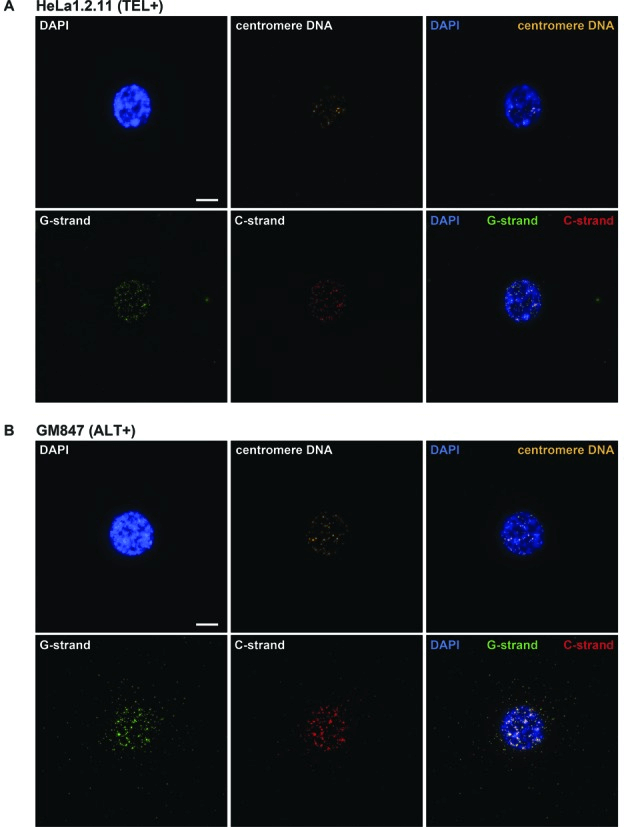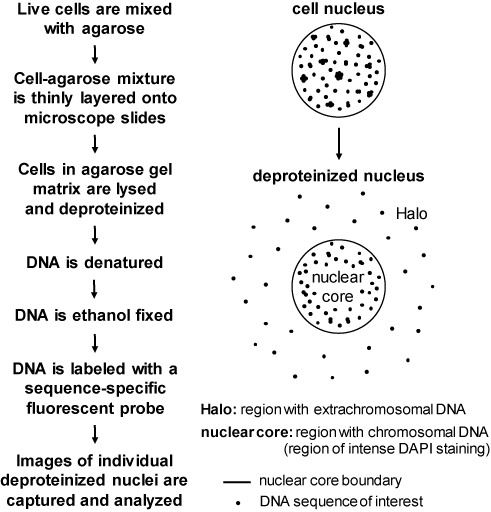HALO-FISH Service
High Resolution FISH and DNA Halo Preparation
One disadvantage of 2D-FISH on intact, fixed nuclei is that the resolution is not high enough, especially for physical mapping. The prolonged release of chromatin in the interphase cell nucleus provides the possibility to resolve sequences that are only 10 kb apart. The DNA halo method uses high salt concentrations and non-ionic detergents to create a DNA ring that remains anchored to the structure within the cell nucleus (nuclear matrix) by connecting regions within the genome. This region contains a variety of soluble nuclear proteins and lipids, such as histones that are not tightly bound to the nuclear matrix. This results in a halo of unlinked DNA around the remaining nucleus, which itself contains DNA that is closely related to the internal nuclear structure and extraction-resistant proteins. Compared with the method of generating extended chromatin fibers by gravity, the preparation of DNA halos produces elongated linearized DNA extruded strands, which can be used for higher resolution mapping. The characteristic of DNA Halo is that certain regions of DNA are still condensed in the nuclear matrix, making it a platform for studying the interaction between the genome and the nuclear matrix.
 Fig 1. A representative image of human cells is characterized by the Halo-FISH protocol. (Komosa M, et al. 2015)
Fig 1. A representative image of human cells is characterized by the Halo-FISH protocol. (Komosa M, et al. 2015)
DNA Halo Preparation and HALO-FISH Services
There is increasing evidence that the nuclear skeleton plays a role in supporting key nuclear processes, including DNA attachment sites, chromatin remodeling, DNA transcription, DNA repair, and DNA replication. DNA halo technology was developed to study the interaction between the nuclear skeleton and the genome during cell activity. We provide a HALO-FISH service based on DNA halo preparation. This service can provide customers with high-resolution physical maps for nuclear matrix and gene interaction analysis. This service is for cell samples, including cultured cells and sperm cells. This service is applicable to cell samples, including cultured cells and sperm cells. The main procedures include sample preparation, probe preparation, DNA halo preparation, 2D-FISH hybridization, imaging and data analysis. We provide many types of commercial probes and customized probe types, including chromosome whole and arm drawing probes. Our imaging and data platform has complete microscope equipment and experienced experimenters to help customers obtain high-quality data and pictures.
 Fig 2. A Halo-FISH method for characterizing extrachromosomal nuclear DNA in mammalian cells. (Godwin L S, et al. 2021)
Fig 2. A Halo-FISH method for characterizing extrachromosomal nuclear DNA in mammalian cells. (Godwin L S, et al. 2021)
Applications
- Study the interactions between the genome and the nuclear skeleton related to disease progression, such as changes in the nuclear structure related to malignant tumors;
- Study the relationship between genome and nuclear skeleton during development and differentiation;
- Halosperm or SpermHalo-FISH for studying the integrity of sperm DNA and determining whether there is DNA damage;
- Evaluate changes in genomic behavior and the impact of specific drug treatments on disease;
- Detection and quantitative analysis of extrachromosomal nuclear DNA in a single mammalian cell;
Creative Bioarray provides a HALO-FISH service based on DNA halo technology. This service combines DNA halos with nucleic acid probes to reveal gene loci, entire chromosomes, alpha satellites, telomeres, and even extrachromosomal DNA. We aim to help researchers explore the nuclear organization and function of normal cells and disease progression (such as cancer). You will benefit from our technical expertise. If you are interested in our HALO-FISH service, please contact us for cooperation. We look forward to cooperating with you in the near future.
References
- Komosa M, Root H, Meyn M S. Visualization and quantitative analysis of extrachromosomal telomere-repeat DNA in individual human cells by Halo-FISH[J]. Nucleic acids research, 2015, 43(4): 2152-2163.
- Godwin L S, Bridger J M, Foster H. Fluorescence in situ hybridization on dna halo preparations to reveal whole chromosomes, telomeres and Gene Loci[J]. Journal of Visualised Experiments, 2021.
All products and services on this website are only suitable for non-medical purposes.


 Fig 1. A representative image of human cells is characterized by the Halo-FISH protocol. (Komosa M, et al. 2015)
Fig 1. A representative image of human cells is characterized by the Halo-FISH protocol. (Komosa M, et al. 2015) Fig 2. A Halo-FISH method for characterizing extrachromosomal nuclear DNA in mammalian cells. (Godwin L S, et al. 2021)
Fig 2. A Halo-FISH method for characterizing extrachromosomal nuclear DNA in mammalian cells. (Godwin L S, et al. 2021)


